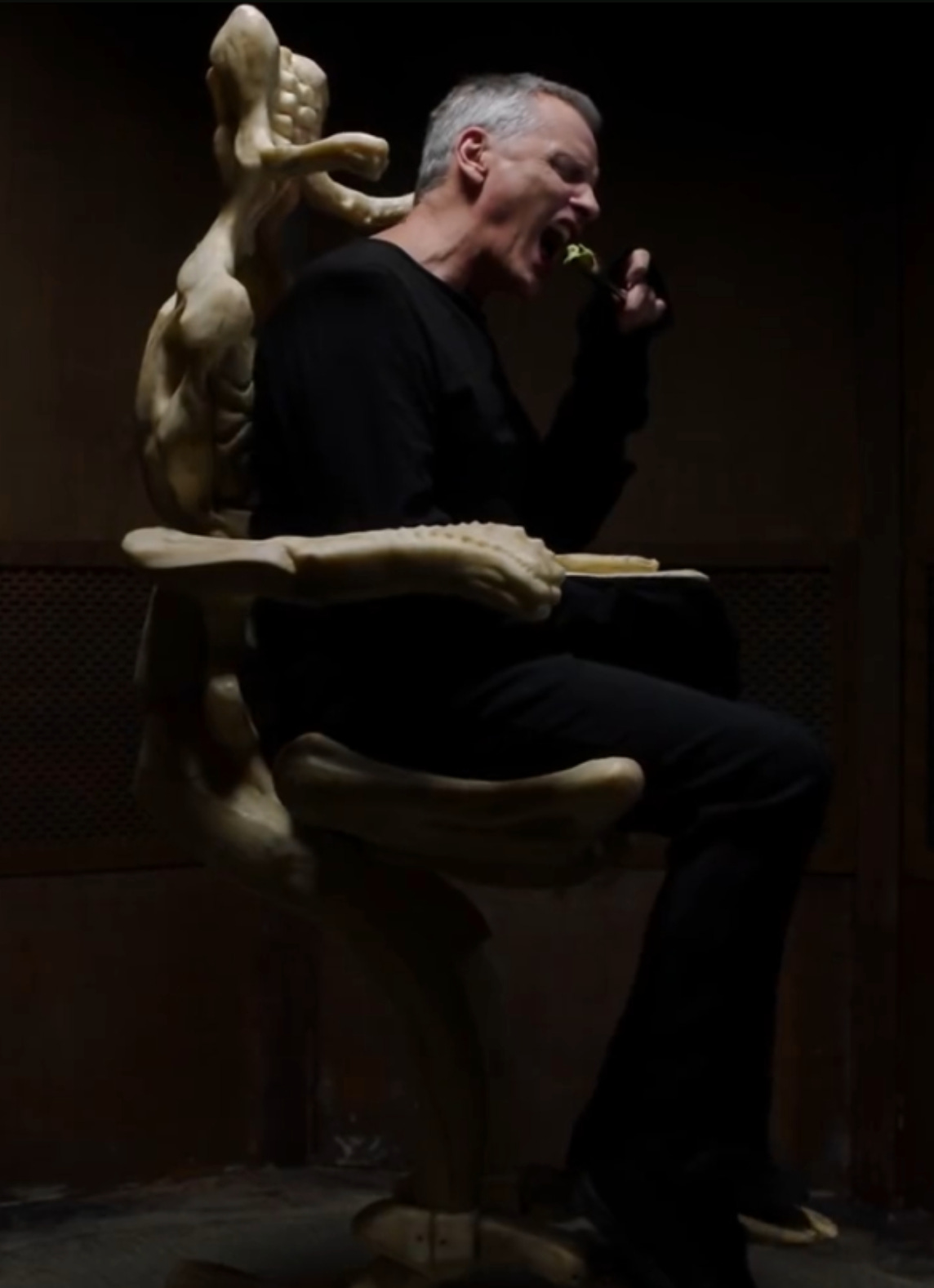Crimes of the Future
deformed notes on body horror, david cronenberg, artaud, francis bacon, forces of deformation and dissolution, medical/erotic gaze, plastic and flesh and text...
“A wound gives off its own light
surgeons say.” (Anne Carson, The Beauty of the Husband)
“the flesh heap…of writing.” (Maurice Blanchot, The Infinite Conversation)
“The cinema is a remarkable stimulant. It acts directly on the gray matter of the brain.” (Antonin Artaud, “Questions and Answers on the Cinema”)
FORCES OF (DE)FORMATION
The three images above show seated forms which are also moving: jerked and contorted as inner and outer forces act on them—-
If there is a soul, where is its seat? Descartes was convinced it was the pineal gland, for its dual nature as both mobile and durable. What moves us?
For Francis Bacon, who rendered invisible forces athletically, the soul’s in the paint. “The spasm of being’ and the ‘rapacious need for flight’ constantly swept the life and poetry of Antonin Artaud,” writes Maurice Blanchot. Sweep our lives, too. Being in a body is hard because there are so many limitations. Those limitations were once God. Now they’re something like the surgical knife-light, or the self. As contemporary creators of ourselves, we may forget that we’re also the created, so creaturely. The body horror artists: Artaud, Bacon, and Cronenberg among them, remind us.
A film is a text which is an analog for a body whose image is moved also by the medium of film itself. In this zone, image equals (de)formation, movement. Moved by electricity, nervous systems, bones, muscles, viscera, special effects.
David Cronenberg, who once said he’s not religious because religion tends to “disembody you,” has a new film, Crimes of the Future, which he’s described as a (dark) comedy. He’s very funny. Freud and Jung writing bitchy letters to each other in A Dangerous Method, for instance.
FORM
The limits of bodies get tested and transgressed as the boundaries between forms and the worlds which house them become dangerously porous. In possession, for instance, a body is inhabited-animated by another entity. It is too open.
In Cronenberg’s zone, inner often means inner organs, forecasting and underscoring our current-future literalism. The Brood’s funny tagline: “THE ULTIMATE EXPERIENCE IN INNER TERROR.”
But inner, as Cronenberg shows, is not synonymous with intimate. Crimes of the Future, where “surgery is the new sex” is a meditation on intimacy and that which mediates intimacy, dilating the lines between a medical gaze and an erotic one, performing a surgery and performing art, innards/guts and psychic interiority, the heart and the heart, plasticities of language and plastic-digesting bodies. Of what is the inside comprised? If surgery is the new sex and the new religion, what are the consequences of worshipping the body? Of eroticizing the medical gaze? Of a world without holy limits?
At its best, body horror brings metaphysical questions both cosmological and ontological about embodiment, ensoulment, and the mind-body relationship into curious relief. Are we our bodies? Are we aliens lugging around meat suits, not meant for this mealy world? Cronenberg’s films often complicate these two questions. It’s both/neither, and weirder.
Can the inner and outer ever match-up? From where does the light emanate? What is a wound? Can we experience pleasure-passion without pain? Is there another world within-around this fleshing floor that made us? Does the light come from the recording device? From film itself? From the injured, open, and emanating body? Is the body a kind of recording device? Is it being recorded, recording other bodies? If so, for what? Love and/or art and/or surveillance and/or…? Is there a metaphysical light? A light from the world of the wound itself?
Furthermore: who or what is operating the instrument (scalpel, camera, body, brush….)?
It’s the longest day of the year in this hemisphere as I write this, the one with the longest drag of sunlight. Who do we think we are, anyway?
MYSTICISM, SPIRIT, FLESH
If Cronenberg is not religious because religion tends to “disembody” then perhaps he’s a kind of mystic or heretic, like Antonin Artaud or Angela of Foligno or Georges Bataille. The sort of mystic-heretic who subverts usual notions of religious dis-embodiment in order to take flight from/into the body in other ways. Ecstasy, usually a departure from the body, happens in the body. The world is “not one with the world it describes,” as poet Inger Christensen wrote. As we are not one with ourselves, though we try and try.
Simon Critchley, in a talk called “Pandemic Mysticism,” muses on why we find it difficult to understand the spirit/flesh relationship that certain mystics wrote about and experienced: “We’ve all apparently become holists or monists, where we are all body and body is all that there is. We’re endlessly encouraged to listen to our body, let the body do the talking, let the body keep the score. This would be nice if it were true, but it isn’t. We are not identical to our bodies. But rather, our experience of ourselves is eccentric, divided from itself. Body holism is a new ideological discourse which is refuted every time we get sick or sit in a dentist’s chair or, even better, are plagued by hypochondriac symptoms[…]Mysticism is an attempt to describe another relation to the body, centered around some distinction between spirit and flesh…mysticism is about the spiritualization of the flesh and the fleshly incarnate nature of the spirit and to understand this requires a certain asceticism. We do not coincide with ourselves, only psychopaths coincide with themselves.”
Crimes of the Future (2022):
Due to the way humans are evolving, many no longer feel pain. Infections have also disappeared. And so, the film presents us with bodies that’ve stopped producing certain signs. Signs of infection include inflammation, fever, exhaustion, various discomforts and gross fluids. We get inhabited by something foreign and our bodies react accordingly. It is this way in love, too. In meeting any other, foreign or familiar.
Pain and passion go together and the future that Cronenberg erects is necessarily devoid of passion, too, at least as we know it, as the other, signs of the other dissolve. In the film, light is not antiseptic and clean, as in the younger Cronenberg’s Antiviral. The light is dark, dingy, and nearly medieval, as risk needn’t be mitigated nor lit in the same ways.
Does a painless wound emit a different light? Anesthetized, we seek out extremes to affirm we’re there — to confirm, too, that the world exists. That there is an outside. And so, in a palliative society, like the one imagined to the umpteenth degree in Crimes of the Future, limits and boundaries widen as we must reach further and further to feel the discomfort which lets the other i.e. life….in. What gives?
Saul Tenser (Viggo Mortensen) is a famous performance artist who does still experience pain as his rapidly changing body grows new organs all the time, which he and his performance partner Caprice (Leá Seydoux) surgically extract during their acts. Some say he’s rebelling against his body by removing these growths while others say he’s preserving what’s human about him. Some say he’s willing these uncomfortable growths for art’s sake. Either way, crowds gather to watch these performance-art-surgeries, seeming to consume and get off on, not just his unruly organs, but his pain. Mystic-like, his body is pain-stage.
There is an intimate hard-to-speak relationship between the production of art and the production of pain. At the end of the film, Saul experiences relief for the first time when he finally eats plastic (human bodies are evolving to digest synthetics), as his partner Caprice films the experience. Will they continue to make art? How will this latest stage of evolution impact the body and bodies of work, performance, what a stage, form, body does, becomes…?
Saul is not preserving his humanity by removing these new organs, as some think. He’s preserving his humanity by preserving his capacity for pain. This requires revolt. Art as revolt against slick progress: a rip from which a light, not necessarily consoling, might come. Though our palliative society likes to say so, it is never as clean as (that which makes) pain = bad and (that which makes) ease = good.
The end of the film delivers a close-up of Saul’s contented face. Contrary to what many critics say, this is definitely not merely some ode to self-acceptance, a feel-good coming-to-terms with progress and human evolution. Cronenberg wouldn’t do us like that. It is the end of revolt, the revolt which makes art possible.
What can’t we digest? In a text, in a film, in an environment. What stays outside as fascination, dread, threat, desire? What stays outside to engine art, the other? Susan Sontag ends her introduction to Artaud’s selected works by saying that culture attempts to assimilate Artaud but he remains “profoundly indigestible.”
Surgery finds its etymological roots in hand + work. The erotic gaze and the medical gaze merge in Crimes of the Future. What we do with our hands and what our hands do with us — greet, gesture in the air, touch —- reveal how we think-feel.
But the body is changing, and with it: sex, spasms, language. The “old sex” (body to body) has been replaced by the “new sex” (body to instrument to body)….heavy on the technology.
This, from Antonin Artaud’s To Have Done with the Judgement of God (1947):
“---By placing him again, for the last time, on the autopsy table to
remake his anatomy.
I say, to remake his anatomy.
Man is sick because he is badly constructed.
We must make up our minds to strip him bare in order to scrape
Off that animalcule that itches him morally
god,
and with god
his organs.
For you can tie me up if you wish,
but there is nothing more useless than an organ.
When you will have made him a body without organs,
then you will have delivered him from all his automatic reactions
and restored him to his true freedom.
Then you will teach him again to dance wrong side out
as in the frenzy of dance halls
and this wrong side out will be his real place.”
Bureaucracy: “judgement of god” “national organ registry”
Foucault, in his conclusion to The Birth of the Clinic, where he muses on life and the medical gaze in a post-autopsy world (the first one on record was 1850), writes: “What was fundamentally invisible is suddenly offered to the brightness of the gaze…” So much visibility, plasticity.
The film’s tagline, “Surgery is the new sex” is also about transparency, x-ray vision, and a deletion of masks, seduction, eroticism, art as the super-pornographic ushers in apocalypse, as in: unveiling. Innards literally on display. Not unlike the digital panopticon. Suddenly, we can see everything, digest everything.







Might be your best Cosmic Edges yet